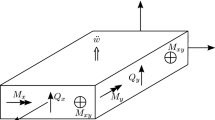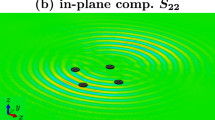Abstract
A comparison was made between two approaches to predict acoustic emission waveforms in thin plates. A normal mode solution method for Mindlin plate theory was used to predict the response of the flexural plate mode to a point source, step-function load, applied on the plate surface. The second approach used a dynamic finite element method to model the problem using equations of motion based on exact linear elasticity. Calculations were made using properties for both isotropic (aluminum) and anisotropic (unidirectional graphite/epoxy composite) materials. For simulations of anisotropic plates, propagation along multiple directions was evaluated. In general, agreement between the two theoretical approaches was good. Discrepancies in the waveforms at longer times were caused by differences in reflections from the lateral plate boundaries. These differences resulted from the fact that the two methods used different boundary conditions. At shorter times in the signals, before reflections, the slight discrepancies in the waveforms were attributed to limitations of Mindlin plate theory, which is an approximate plate theory. The advantages of the finite element method are that it used the exact linear elasticity solutions, and that it can be used to model real source conditions and complicated, finite specimen geometries as well as thick plates. These advantages come at a cost of increased computational difficulty, requiring lengthy calculations on workstations or supercomputers. The Mindlin plate theory solutions, meanwhile, can be quickly generated on personal computers. Specimens with finite geometry can also be modeled. However, only limited simple geometries such as circular or rectangular plates can easily be accommodated with the normal mode solution technique. Likewise, very limited source configurations can be modeled and plate theory is applicable only to thin plates.
Similar content being viewed by others
REFERENCES
F. R. Breckenridge, Carl E. Tschiegg, and M. Greenspan, Acoustic Emission: Some Applications of Lamb's Problem, J. Acoust. Soc. Am. 57(3), 626–631 (1975).
N. N. Hsu, Dynamic Green's Functions of an Infinite Plate—A Computer Program, NBSIR 85–3234 (1985).
Y. H. Pao, Theory of Acoustic Emission, Elastic Waves and Non-Destructive Testing of Materials, AMD 29, 107–128 (1978).
M Ohtsu and K. Ono, The Generalized Theory and Source Representations of Acoustic Emission, J. Acoustic Emission 5(4), 124–133 (1986).
M. R. Gorman, Plate Wave Acoustic Emission, J. Acoust. Soc. Am. 90(1), 358–364 (1991).
M. R. Gorman and W. H. Prosser, AE Source Orientation by Plate Wave Analysis, J. Acoustic Emission 9(4), 283–288 (1991).
S. M. Ziola and M. R. Gorman, Source Location in Thin Plates Using Cross-Correlation, J. Acoust. Soc. Am. 90(5), 2551–2556 (1991).
M. R. Gorman and S. M. Ziola, Plate Waves Produced by Transverse Matrix Cracking, Ultrasonics 29, 245–251 (1991).
W. H. Prosser, K. E. Jackson, S. Kellas, B. T. Smith, J. McKeon, and A. Friedman, Advanced, Waveform Based Acoustic Emission Detection of Matrix Cracking in Composites, Materials Evaluation 53(9), 1052–1058 (1995).
W. H. Prosser, The Propagation Characteristics of the Plate Modes of Acoustic Emission Waves in Thin Aluminum Plates and Thin Graphite/Epoxy Composite Plates and Tubes, NASA Technical Memorandum 104187 (1991).
D. Guo, A. Mal, and K. Ono, Wave Theory of Acoustic Emission in Composite Laminates, J. Acoustic Emission, 14(3–4), S19-S46 (1996).
D. Guo, Lamb Waves from Microfractures in Composite Plates, Ph.D. Thesis, University of California at Los Angeles (1996).
M. R. Gorman and W. H. Prosser, Application of Normal Mode Expansion to Acoustic Emission Waves in Finite Plates, J. Appl. Mech. 63(2), 555–557 (1996).
R. D. Mindlin, Influence of Rotatory Inertia and Shear on Flexural Motions of Isotropic Elastic Plates, J. Appl. Mech. 18, 31–38 (1951).
W. Huang, Application of Mindlin Plate Theory to Analysis of Acoustic Emission Waveforms in Finite Plates, to be published in the Proceedings of the Review of Progress in Quantitative Nondestructive Evaluation 17 (1998).
J. Gary and M. A. Hamstad, On the Far-field Structure of Waves Generated by a Pencil Lead Break on a Thin Plate. J. Acoustic Emission 12(3–4), 157–170 (1994).
M. A. Hamstad, J. Gary, and A. O'Gallagher, Far-field Acoustic Emission Waves by Three-Dimensional Finite Element Modeling of Pencil-Lead Breaks on a Thick Plate, J. Acoustic Emission 14(2), 103–114 (1996).
P.C. Yang, C. H. Norris, and Y. Stavsky, Elastic Wave Propagation in Heterogeneous Plates, Int. J. Solids Struct. 2, 665 (1966).
B. Tang, E. G. Henneke II, and R. C. Stiffler, Low Frequency Flexural Wave Propagation in Laminated Composite Plates, Proceedings of Workshop on Acousto-Ultrasonics: Theory and Applications, 45–65 (1987).
T. S. Chow, On the Propagation of Flexural Waves in an Orthotropic Laminated Plate and Its Response to an Impulsive Load, J. Comp. Mat. 5, 306–319 (1971).
Author information
Authors and Affiliations
Rights and permissions
About this article
Cite this article
Prosser, W.H., Hamstad, M.A., Gary, J. et al. Finite Element and Plate Theory Modeling of Acoustic Emission Waveforms. Journal of Nondestructive Evaluation 18, 83–90 (1999). https://doi.org/10.1023/A:1021888009896
Issue Date:
DOI: https://doi.org/10.1023/A:1021888009896




